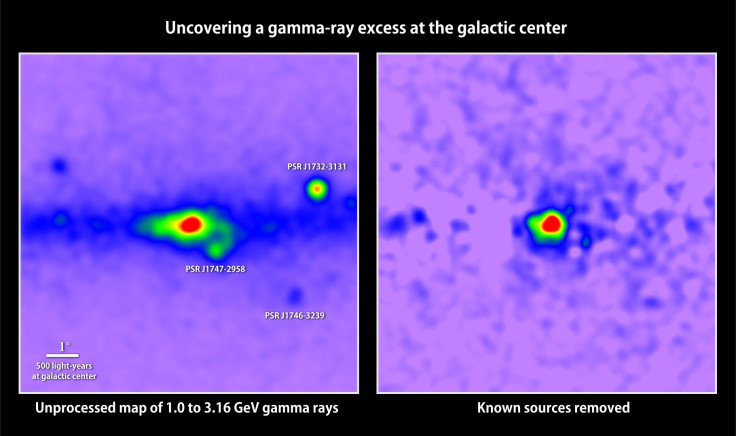Gamma-Ray Light From Milky Way’s Galaxy May Hold Clues To Dark Matter

Astronomers have conducted a new study of gamma-ray light from the center of the Milky Way galaxy that suggests that some of this emission could arise from dark matter, a hypothetical substance that is believed to make up most of the material universe.
Scientists at the Fermi National Accelerator Laboratory, or Fermilab, the Harvard-Smithsonian Center for Astrophysics, the Massachusetts Institute of Technology and the University of Chicago used publicly available data from NASA's Fermi Gamma-ray Space Telescope and developed new maps showing that the center of the Milky Way galaxy produces more high-energy gamma rays than can be explained by known sources. According to the scientists, this excess emission is consistent with some forms of dark matter.
“The new maps allow us to analyze the excess and test whether more conventional explanations, such as the presence of undiscovered pulsars or cosmic-ray collisions on gas clouds, can account for it,” Dan Hooper, an astrophysicist at Fermilab in Batavia, Ill. and a lead author of the study, said in a statement. “The signal we find cannot be explained by currently proposed alternatives and is in close agreement with the predictions of very simple dark matter models.”
While scientists are not sure about the nature of dark matter, there is a class of theoretical candidates called Weakly Interacting Massive Particles, or WIMPs, which could produce gamma rays in ranges that Fermi could detect. When astronomers carefully subtract all known gamma-ray sources from the observations of the galactic center, performed by Fermi's Large Area Telescope, a patch of leftover emission remains.
According to Hooper and his team of the scientists, annihilations of dark-matter particles with a mass between 31 and 40 electron volts (GeV) “provide a remarkable fit for the excess based on its gamma-ray spectrum, its symmetry around the galactic center, and its overall brightness.”
“Dark matter in this mass range can be probed by direct detection and by the Large Hadron Collider (LHC), so if this is dark matter, we're already learning about its interactions from the lack of detection so far,” Tracy Slatyer, a theoretical physicist at MIT in Cambridge, Mass., said in the statement. “This is a very exciting signal, and while the case is not yet closed, in the future we might well look back and say this was where we saw dark-matter annihilation for the first time.”
However, the researchers caution that it will take multiple sightings to validate their dark-matter interpretation.
“Our case is very much a process-of-elimination argument. We made a list, scratched off things that didn't work, and ended up with dark matter,” said Douglas Finkbeiner, a co-author of the study.
Check out the video here:
© Copyright IBTimes 2024. All rights reserved.






















